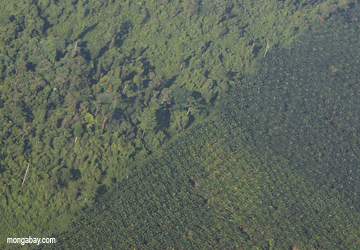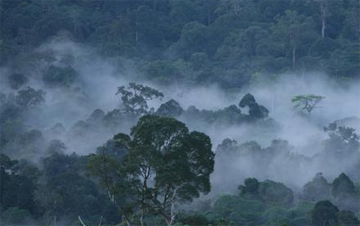Old growth forests are carbon sinks for centuries, helping offset emissions
Old growth forests are carbon sinks for centuries, helping offset emissions
Rhett A. Butler, mongabay.com
September 11, 2008
|
|
Old growth forests are important carbon sinks that help global warming, reports a study published in the journal Nature. The results run counter to claims by the forestry industry that old growth forests are carbon neutral or even net emitters of carbon dioxide.
Analyzing 519 studies of plots from forests around the world, Sebastiaan Luyssaert of the University of Antwerp and colleagues found that old growth forests in boreal and temperate zones of the Northern Hemisphere alone — about 15 percent of global forest cover — sequester 0.8 to 1.8 billion tons of carbon per year.
“Old-growth forests accumulate carbon for centuries and contain large quantities of it,” the authors write. “We expect, however, that much of this carbon, even soil carbon, will move back to the atmosphere if these forests are disturbed.”
 Oil palm plantation and logged-over forest in Sabah, a Malaysian state on the island of Borneo.  Mist over the rainforest in Malaysian Borneo |
The findings — which are based on a broader data set than prior studies1 — are significant because old-growth forests worldwide are being replaced by forest plantations 2. Previous research has shown that once plantations reach maturity, they become net emitters of carbon. In contrast, old-growth forests continue to accumulate carbon in their vegetation and soils.
“In fact, young forests rather than old-growth forests are very often conspicuous sources of CO2 because the creation of new
forests (whether naturally or by humans) frequently follows disturbance to soil and the previous vegetation, resulting in a decomposition rate of coarse woody debris, litter and soil organic matter… that exceeds the net primary production of the regrowth,” Luyssaert write.
“The current data now makes it clear that carbon accumulation can continue in forests that are centuries old,” added co-author Beverly Law, a professor of forest science at Oregon State University and director of the AmeriFlux network, a group of 90 research sites in North and Central America that is monitoring the current global “budget” of carbon dioxide.
The authors end by arguing for the inclusion of old-growth forests in climate change mitigation programs.
“Carbon-accounting rules for forests should give credit for leaving old-growth forest intact,” they conclude.
CITATION: Sebastiaan Luyssaert et al (2008). Old-growth forests as global carbon sinks. NATURE| Vol 455| 11 September 2008
(1) The long-standing view that old-growth forests are carbon neutral was originally based on ten years’ worth of data from a single site and has been supported by research that shows a decline in net primary productivity with age in plantations, according to the authors.
(2) U.N. data shows that more than 15 million hectares of forest were destroyed each year during the 1990s, including 6 million hectares of primary forests. Meanwhile tropical forest plantations expanded by almost 5-fold since 1980. In 2006 alone Brazil planted more than 627,000 hectares of industrial forest plantations.
Related
14 countries win REDD funding to protect tropical forests 7/24/2008
Fourteen countries have been selected by the World Bank to receive funds for conserving their tropical forests under an innovative carbon finance scheme.
Markets could save rainforests: an interview with Andrew Mitchell 8/17/2008
Markets may soon value rainforests as living entities rather than for just the commodities produced when they are cut down, said a tropical forest researcher speaking in June at a conservation biology conference in the South American country of Suriname. Andrew Mitchell, founder and director of the London-based Global Canopy Program (GCP), said he is encouraged by signs that investors are beginning to look at the value of services afforded by healthy forests.
Emissions from deforestation offset by increased tree growth in the Amazon 3/10/2008
An increase in carbon sequestration by trees in the Amazon has roughly offset total emissions from deforestation in the region since the 1980s. A new study, published in Philosophical Transactions of the Royal Society B, this trend may slow in the future, causing the world’s largest rainforest to become a net source of carbon emissions and therefore contributing to climate change.
Is the Amazon more valuable for carbon offsets than cattle or soy?
10/17/2007
After a steep drop in deforestation rates since 2004, widespread fires in the Brazilian Amazon (September and October 2007) suggest that forest clearing may increase this year. All told, since 2000 Brazil has lost more than 60,000 square miles (150,000 square kilometers) of rainforest — an area larger than the state of Georgia or the country of Bangladesh. Most of this destruction has been driven by clearing for cattle pasture and agriculture, often in association with infrastructure development and improvements. Higher commodity prices, especially for beef and soy, have further spurred forest conversion in the region.